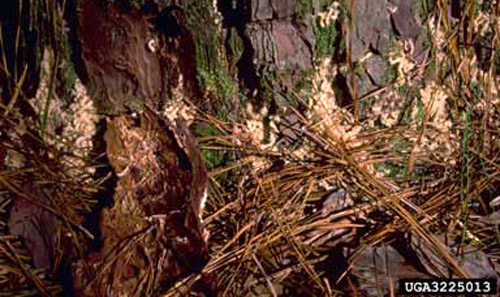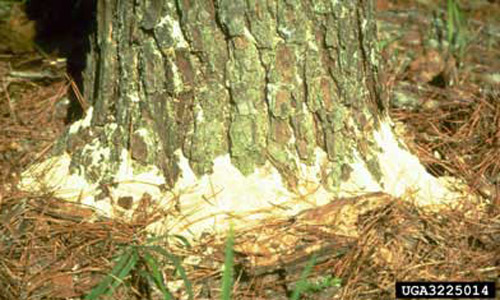common name: ambrosia beetles
scientific name: Platypus spp. (Insecta: Coleoptera: Platypodidae)
Introduction - Identification - Key to Species of Platypus of Florida - Biology - Distribution - Damage - Selected References
Introduction (Back to Top)
The family Platypodidae includes over 1,000 species, most of which are found in the tropics (Schedl 1972). Seven species of platypodids, all in the genus Platypus, are found in the United States, four of which occur in Florida. All species found in Florida are borers of trunks and large branches of recently killed trees and may cause economic damage to unmilled logs or standing dead timber. The most recent key to species was published 60 years ago (Chamberlin 1939), does not include all species known from the United States (Wood 1979), and has long been out of print.
Identification (Back to Top)
The Platypodidae are closely related to the Scolytidae, but can be distinguished by the elongate body form, short abdomen (shorter than metathorax in lateral view), and elongate first tarsal segment which is longer than the remaining segments combined.
Figure 1. Dorsal view of male Platypus flavicornis Fabricius. Photograph by David T. Almquist, University of Florida.
Figure 2. Lateral view of adult male Platypus flavicornis (Fabricius). White line represents 1 mm. Photograph by T.H. Atkinson, University of Florida.
Figure 3. Ventral view of head of an adult female Platypus flavicornis (Fabricius). White line represents 1 mm. Photograph by T.H. Atkinson, University of Florida.
Figure 4. Ventral view of head of an adult male Platypus flavicornis (Fabricius). White line represents 1 mm. Photograph by T.H. Atkinson, University of Florida.
Figure 5. Prothoracic leg of Platypus flavicornis (Fabricius) showing length of tarsal segments. White line represents 1 mm. Photograph by T.H. Atkinson, University of Florida.
Figure 6. Pronotum of adult female Platypus compositus (Say). White line represents 1 mm. Photograph by T.H. Atkinson, University of Florida.
Figure 7. Pronotum of adult female Platypus quadridentatus (Olivier). White line represents 1 mm. Photograph by T.H. Atkinson, University of Florida.
Males of all species have more developed armature (spineous or chitinous processes) of the elytral declivity (sloping area) than females.
Figure 8. Male declivity in Platypus flavicornis (Fabricius). White line represents 1 mm. Photograph by T.H. Atkinson, University of Florida.
Figure 9. Female declivity in Platypus flavicornis (Fabricius). White line represents 1 mm. Photograph by T.H. Atkinson, University of Florida.
Figure 10. Male declivity in Platypus compositus (Say). White line represents 1 mm. Photograph by T.H. Atkinson, University of Florida.
Figure 11. Female declivity in Platypus compositus (Say). White line represents 1 mm. Photograph by T.H. Atkinson, University of Florida.
Figure 12. Male declivity in Platypus parallelus (Fabricius). White line represents 1 mm. Photograph by T.H. Atkinson, University of Florida.
Figure 13. Female declivity in Platypus parallelus (Fabricius) . White line represents 1 mm. Photograph by T.H. Atkinson, University of Florida.
Figure 14. Male declivity in Platypus quadridentatus (Olivier). White line represents 1 mm. Photograph by T.H. Atkinson, University of Florida.
Figure 15. Female declivity in P. quadridentatus (Olivier). White line represents 1 mm. Photograph by T.H. Atkinson, University of Florida.
Females of species occurring in Florida lack terminal spines on the elytra except for Platypus flavicornis (Fabricius) which has blunt projections. Females of all species have larger maxillary palpi and a larger gular region than males. (See figures displaying ventral view of heads.)
The following key and accompanying illustrations will allow identification of both sexes of all species occurring in Florida and the eastern United States.
Key to Species of Platypus of Florida (Back to Top)
1. Male declivity with large acuminate process arising from interstria 9 on posterolateral margins of elytra; interstria 3 continuing posteriorly as a spinose process, interstria 1 not elevated (Figures 5, 13); female declivity with blunt projection at apex of interstria 3 or at apex of interstria 9, apical margin of declivity straight, not explanate (spread out and flattened) (Figures 6, 14) . . . . . 2
1' Male declivity with large blunt process arising from interstria 9 on posterolateral margins of elytra ending in three terminal spines; interstria 1 continuing posteriorly as a spinose process, interstria 3 not elevated or conspicuously less so than 1 (Figures 8, 11); female declivity blunt, without projecting apical tubercles or processes, apical
margin of declivity shallowly divaricate (forked) at suture, slightly explanate (Figures 9, 12) . . . . . 3
2(1). Male declivity with prominent spines on venter of third visible abdominal segment, posterolateral processes of declivity laterally compressed (Figure 13); female declivity without apical projection of posterolatreal area of elytra (Figure 14); female pronotum with pair of large conspicuous pores in middle (Figure 15). Southeastern U.S. In oaks . . . . . quadridentatus (Olivier)
2' Male declivity without spines on venter of abdomen; posterolateral processes of declivity acute, not compressed (Figure 5); female declivity with blunt posterolateral projections on elytra, less acute than those of male (Figure 6); female pronotum without conspicuous pores. Southeastern U.S. In pines . . . . . flavicornis (Fabricius)
3(1). Pronotum of both sexes with a pair of tiny pores in middle (Figure 10); male elytral stride shallowly impressed, interstriae 3 times as wide as striae at base of declivity (Figure 8). Southeastern U.S. Neotropics . . . . . compositus (Say)
3' Pronotum without conspicuous pores in either sex; male elytral striae deeply impressed, subequal in width to interstriae at base of declivity (Figure 11). Southern Florida. Circumtropical . . . . . parallellus (Fabricius)
Biology (Back to Top)
All species are ambrosia beetles and generally breed in large diameter host material. Galleries are initiated by males; each male is joined by a single female. Pheromones are produced and large numbers of simultaneous attacks are frequently observed. Mated pairs tunnel into the heartwood and introduce ectosymbiotic fungi into their tunnels upon which they and their brood feed. For the most part the wood is not actually consumed. Larvae move freely inside the parental tunnels and excavate individual pupal cells off the main tunnels. Adults emerge through the original entry hole. Platypodids can only breed in undegraded, recently killed host material, with a high moisture content. Decaying wood or wood which has dried out is unsuitable. Normally, only a single generation can be produced in a given host. Platypus flavicornis and Platypus quadridentatus are respectively restricted to pines and oaks. Platypus compositus and Platypus parallelus are extremely polyphagous and will breed in most trees within their ranges. These latter two species are commonly attracted to light.
Distribution (Back to Top)
Figure 16. Distribution of Platypus compositus (Say). Based on Beal & Massey (1945), Blackman (1922), Wood (1958, 1979), Staines (1981) and personal observations. Photograph by T.H. Atkinson, University of Florida.
Figure 17. Distribution of Platypus flavicornis (Fabricius). Based on Beal & Massey (1945), Blackman (1922), Wood (1958, 1979), Staines (1981) and personal observations. Photograph by T.H. Atkinson, University of Florida.
Figure 18. Distribution of Platypus parallelus (Fabricius). Based on Beal & Massey (1945), Blackman (1922), Wood (1958, 1979), Staines (1981) and personal observations. Photograph by T.H. Atkinson, University of Florida.
Figure 19. Distribution of Platypus quadridentatus (Olivier). Based on Beal & Massey (1945), Blackman (1922), Wood (1958, 1979), Staines (1981) and personal observations. Photograph by T.H. Atkinson, University of Florida.
Damage
Figure 20. Dust at base of tree resulting from boring of the ambrosia beetle Platypus flavicornis Fabricius. Photograph by Ronald F. Billings, Texas Forest Service, www.forestryimages.org.
Figure 21. Dust (stage 3) at base of tree resulting from feeding of the ambrosia beetle Platypus flavicornis Fabricius. Photograph by Ronald F. Billings, Texas Forest Service, www.forestryimages.org.
Selected References (Back to Top)
- Beal JA, Massey CL. 1945. Bark beetles and ambrosia beetles (Coleoptera: Scolytoidea) with special reference to the species occurring in North Carolina. Duke University School of Forestry Bulletin No. 10. 178 pp.
- Blackman MW. 1922. Mississippi bark beetles. Mississippi Agricultural Experiment Station Technical Bulletin 11: 1-130.
- Chamberlin WJ. 1939. The bark and timber beetles of North America north of Mexico. Oregon State University, Corvallis. 513 p.
- Schedl KE. 1972a. Monographie der Famile Platypodidae (Coleoptera). W. Junk, the Hague. 322 p.
- Staines CL. 1982. Distributional records of Platypodidae (Coleoptera) in Maryland. Proceedings of the Entomology Society of Washington 84: 858-859.
- Wood SL. 1958. Some virtually unknown North American Platypodidae (Coleoptera). Great Basin Naturalist 18: 37-40.
- Wood SL. 1979. Family Platypodidae. A Catalog of the Coleoptera of America north of Mexico, fasc. 141. U.S. Department of Agriculture Handbook 529-141. 5 p.


